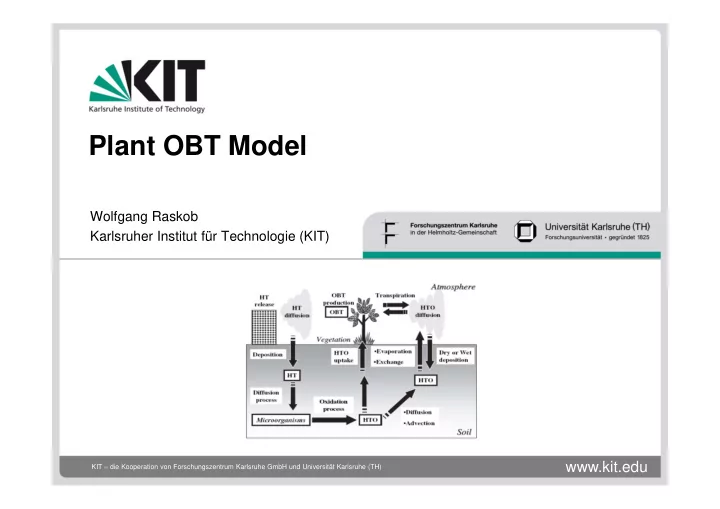

Plant OBT Model Wolfgang Raskob Karlsruher Institut für Technologie (KIT) www.kit.edu KIT – die Kooperation von Forschungszentrum Karlsruhe GmbH und Universität Karlsruhe (TH)
Objectives of Plant OBT A physically based approach, considering all the necessary transport and transformation processes Improvement of the present plant sub-model of the assessment code UFOTRI Pre- and recalculation of experimental work to get a better understanding and to identify areas of model and experimental design improvements Treat day and night releases correctly high air concentrations at night, rather low at daytime uptake at night might be important (rate of tritium intake into the plant is only by a factor of about 4-5 lower compared to daytime values, results from wheat exposure experiments performed at FZK) 2 25.01.2011 Karlsruhe Institute of Technology (KIT-IKET) Tritium modelling overview
Flow chart Plant OBT ear OBT ear TRANS ear TWT leaf OBT atmosphere leaf TRANS grain OBT HTO leaf TWT grain TWT stem OBT stem TRANS stem TWT 3 25.01.2011 Karlsruhe Institute of Technology (KIT-IKET) Tritium modelling overview
Regulatory requirements for a model Processes important for the OBT formation: 1. light dependent: photosynthesis photorespiration 2. light independent maintenance respiration basic metabolism Subdivision of the wheat plant into three parts: stem leaves ears (+ grains) Contribution of the individual organs to the total process: stem: 10% leaves: 60% ears: 30% 4 25.01.2011 Karlsruhe Institute of Technology (KIT-IKET) Tritium modelling overview
OBT production (non-exchangeable) COBT COBT Re d P B CTWT / W spec 0 act spec d where: COBT spec specific OBT concentration in Bq/g dry matter COBT 0 initial specific OBT concentration in Bq/g dry matter CTWT spec specific TWT concentration in Bq/g water P act net photosynthesis rate B basic metabolism rate Red reduction factors such as isotopic effect, H2 content and exchangeable / non exchangeable fraction W d dry matter content in g 5 25.01.2011 Karlsruhe Institute of Technology (KIT-IKET) Tritium modelling overview
Respiration rate, expressed in CO2 equivalents R = photorespiration + maintenance respiration R C 1 P C 2 W p c m d where: C1 p P c photorespiration, dependent on the photosynthesis rate C2 m W d maintenance respiration, dependent on the plant weight C1 p C2 m constants 6 25.01.2011 Karlsruhe Institute of Technology (KIT-IKET) Tritium modelling overview
BIOMOVS test of wheat exposure at day-time 'Day' exposure: TWT and OBT -1.2 2.1 Plant-OBT Plant-OBT -1.9 STAR H-3 (1) STAR H-3 (1) 1.7 -2.9 1.1 STAR H-3 (2) STAR H-3 (2) TWT -2.6 1.2 OBT UFOTRI UFOTRI -2.6 1.1 UFOTRI-AECL UFOTRI-AECL models excluding OBT formation during the night -2.8 ETMOD ETMOD 1.1 -2.7 TRICAROM TRICAROM -1.4 -5.3 1.1 TRIMOVS (1) TRIMOVS (1) 1.1 -1.1 TRIMOVS (2) TRIMOVS (2) 2 1 2 3 3 4 5 5 4 5 -4 -3 -2 -1 0 1 2 3 4 5 lower higher deviation from observation TWT in leaves after exposure, OBT at harvest 7 25.01.2011 Karlsruhe Institute of Technology (KIT-IKET) Tritium modelling overview
BIOMOVS test of wheat exposure at night-time 'Night' exposure: TWT and OBT -1.1 Plant-OBT Plant-OBT -1.2 1.4 -2.1 STAR H-3 (1) STAR H-3 (1) -3.1 1.0 STAR H-3 (2) STAR H-3 (2) TWT -2.5 OBT -3.1 UFOTRI UFOTRI -2.4 UFOTRI-AECL UFOTRI-AECL -2.4 >-100 models excluding OBT formation during the night ETMOD ETMOD -21 TRICAROM TRICAROM -9.1 -3.6 -4.0 TRIMOVS (1) TRIMOVS (1) -54 -4.0 -7.5 TRIMOVS (2) TRIMOVS (2) 5 4 1 3 2 2 4 3 -4 -3 -2 -1 0 1 2 3 4 5 lower higher deviation from observation TWT in leaves after exposure, OBT at harvest 8 25.01.2011 Karlsruhe Institute of Technology (KIT-IKET) Tritium modelling overview
OBT-FORMATION: rel. OBT grain at harvest, related toTWT in leaves at the end of exposure (Plant OBT) 1,0 0,9 0,8 grain OBTmes 0,7 grain OBT mod polynomial fit 0,6 % 0,5 0,4 0,3 0,2 mean 0.23 % 0,1 0,0 6 8 10 12 14 16 18 20 22 24 Time of day (h) at the beginning of exposure 9 25.01.2011 Karlsruhe Institute of Technology (KIT-IKET) Tritium modelling overview
Conclusion Yes, there is a need of a physical based tritium OBT model approach Before developing models, it is necessary to carry out a sensitivity analysis about the importance of the processes Sub-models for assessment codes should be as simple as possible, but physically based The ‘PLANT-OBT’ model considers the relevant processes (light dependent and independent), even if the parameterisation is sometimes still too simple (basic metabolism) Non tritium part (growth) of the ‘PLANT-OBT’ model was successfully tested Parameterisation of the photosynthesis process is still under discussion for the OBT formation (specific tritium activity in the photosynthetic cell organs) 10 25.01.2011 Karlsruhe Institute of Technology (KIT-IKET) Tritium modelling overview
Recommend
More recommend